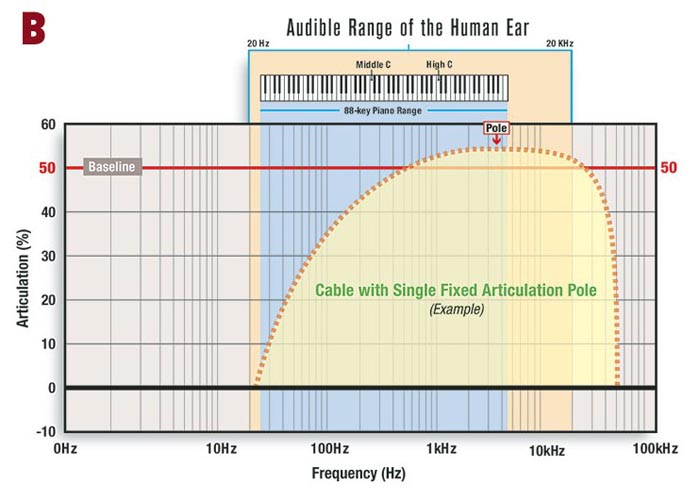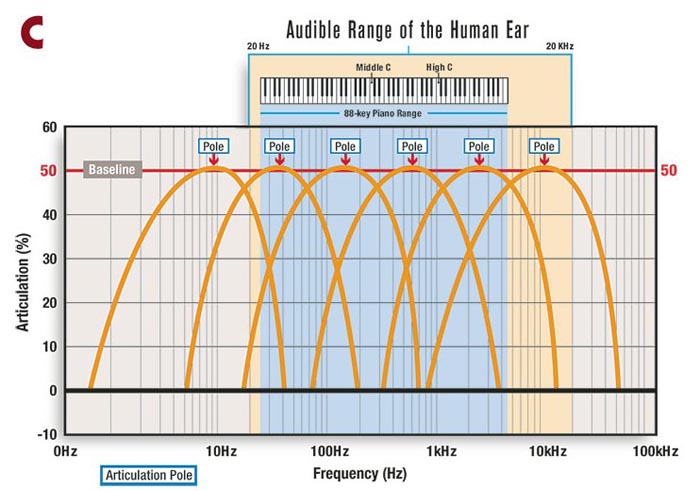This review page is supported in part by the sponsors whose ad banners are displayed below |
 |
 |
I asked Kent Loughlin, VP of MIT several questions regarding the filter and multi-pole technology which he summarized thus: "The common approach to making an audio cable and in particular a different sounding cable is to change the components used for construction or sometimes the winding geometry. For cable companies, there are limitless choices regarding the dielectric, metal, coatings on the metals, long grain, oxygen-free coppers etc. Some have even used water as a dielectric. It's all for the purpose of making the components work best with each other or to add some 'pizzazz' or attenuate some hash or grunge. Audio cables, just like preamplifiers and amplifiers, all function as a low pass filter. They pass the lows and attenuate the highs. Hopefully they will not attenuate the highs until some frequency much higher than 20kHz. However, while audio cables do function as low pass filters, they are inefficient low pass filters. They store more energy at some frequencies than at others. Audio cables therefore transport more power at some frequencies than they do others, skewing both the magnitude and the phase. I like to use the charts below to demonstrate the effects of Multipole™ technology.
|
 |
"Graph A represents the bandwidth of an 88-key piano highlighted in blue as it compares to the audible range of the human ear. We will use this graph to describe how well a cable articulates across the audible bandwidth. |
 |
|
|
"Graph B shows a standard single-pole cable to have a relatively narrow region (the yellow arch) where it is articulating ideally. Note that the blue area remaining is considered less than ideal in terms of articulation.
 "Graph C demonstrates the effect of MIT’s patented Multipole™ network technology when additional poles/points (six are shown) further extend the 'articulation bandwidth' of the audio system so that you can hear all of the musical information from the lows to the highs with equal efficiency. "Graph C demonstrates the effect of MIT’s patented Multipole™ network technology when additional poles/points (six are shown) further extend the 'articulation bandwidth' of the audio system so that you can hear all of the musical information from the lows to the highs with equal efficiency.
 "As you can see, we deal with the pole of the conductor or filter. Pole? Yes, a pole is a point of articulation where the LCR are in perfect balance to transfer energy without loss or distortion. Every filter has one which can be seen on a complex impedance analyzer. That said, the pole can be moved up the bandwidth for more high frequency efficiency (at the sacrifice of bass) or it can be moved to the left of center to create a pole more attuned to transferring bass (at the sacrifice of the treble). Most audio cables will have the pole quite close to middle C and for good reason; half of what we hear musically is either above or below middle C. These conventional non-parallel networked designs would all be single pole designs. You can easily see why one audiophile might prefer silver speaker cables on a pair of 8wpc 300B SETs where it would be unlistenable on a Krell or other solid-state amp with a penchant for the high frequencies. Enter multi-pole technology. Multi pole takes additional conductors and adds (to them) the networks that will cause additional points of articulation along the audio bandwidth; additional to the base pole that the first pair of conductors would have to begin with. One at a time, additional conductors are laid in parallel to the mains, each with a combination that will create another pole or additional point of articulation. When the poles line up with each other in terms of magnitude of articulation (not SPLs) and on a frequency that is a musical frequency, then look out! Everything falls into place, the noise floor drops, the sonic envelope becomes larger and the images are suspended with more definition and stability. "As you can see, we deal with the pole of the conductor or filter. Pole? Yes, a pole is a point of articulation where the LCR are in perfect balance to transfer energy without loss or distortion. Every filter has one which can be seen on a complex impedance analyzer. That said, the pole can be moved up the bandwidth for more high frequency efficiency (at the sacrifice of bass) or it can be moved to the left of center to create a pole more attuned to transferring bass (at the sacrifice of the treble). Most audio cables will have the pole quite close to middle C and for good reason; half of what we hear musically is either above or below middle C. These conventional non-parallel networked designs would all be single pole designs. You can easily see why one audiophile might prefer silver speaker cables on a pair of 8wpc 300B SETs where it would be unlistenable on a Krell or other solid-state amp with a penchant for the high frequencies. Enter multi-pole technology. Multi pole takes additional conductors and adds (to them) the networks that will cause additional points of articulation along the audio bandwidth; additional to the base pole that the first pair of conductors would have to begin with. One at a time, additional conductors are laid in parallel to the mains, each with a combination that will create another pole or additional point of articulation. When the poles line up with each other in terms of magnitude of articulation (not SPLs) and on a frequency that is a musical frequency, then look out! Everything falls into place, the noise floor drops, the sonic envelope becomes larger and the images are suspended with more definition and stability.
Each of the three modules will have the ability to ring up certain points for the purpose of cleaning up the points that each are assigned to. As far as cable construction goes, we start with OFC that is .999999% pure. The interconnects will have the copper silver plated but the speaker cables are pure copper."
|
|
|
|
|
 |
|
 |
|